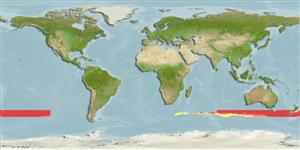Elasmobranchii (sharks and rays) >
Squaliformes (Sleeper and dogfish sharks) >
Somniosidae (Sleeper sharks)
Etymology: Scymnodalatias: scymno-, referring to previous placement in Scymnodon; dalatias, referring to lack of dorsal spines like most sharks in the family Dalatiidae (sometimes included within Somniosidae) (See ETYFish); albicauda: albus (L.), white; cauda (L.), tail, referring to white markings on caudal fin (See ETYFish).
Environment: milieu / climate zone / depth range / distribution range
Ecology
Marine; bathypelagic; oceanodromous (Ref. 51243); depth range 150 - 510 m (Ref. 6871). Deep-water; 42°S - 50°S
Eastern Indian Ocean: southern Australia. Southwest Pacific: New Zealand.
Size / Weight / Age
Maturity: Lm ? range ? - ? cm
Max length : 111 cm TL male/unsexed; (Ref. 26346)
Short description
Identification keys | Morphology | Morphometrics
Dorsal spines (total): 0. Grey and white, mottled with large brown or black spots; tail mostly white with black tips (Ref. 26346). Dorsal fins small, pectoral fins angular, and an asymmetric caudal fin with a dark-tipped upper lobe (Ref. 6871).
Oceanic (Ref. 6871). A rare species known only from a few specimens taken by tuna longliners and trawlers (Ref. 6871). Ovoviviparous (Ref. 205), with at least 59 young in a litter (Ref. 26346).
Life cycle and mating behavior
Maturity | Reproduction | Spawning | Eggs | Fecundity | Larvae
Probably ovoviviparous (Ref. 6871), with at least 59 young (Ref. 26346). Distinct pairing with embrace (Ref. 205).
Last, P.R. and J.D. Stevens, 1994. Sharks and rays of Australia. CSIRO, Australia. 513 p. (Ref. 6871)
IUCN Red List Status (Ref. 130435: Version 2024-1)
Threat to humans
Harmless
Human uses
Fisheries: bycatch
Tools
Special reports
Download XML
Internet sources
Estimates based on models
Preferred temperature (Ref.
123201): 7.2 - 11.8, mean 9.2 °C (based on 20 cells).
Phylogenetic diversity index (Ref.
82804): PD
50 = 0.5625 [Uniqueness, from 0.5 = low to 2.0 = high].
Bayesian length-weight: a=0.00380 (0.00164 - 0.00880), b=3.14 (2.95 - 3.33), in cm total length, based on LWR estimates for this (Sub)family-body shape (Ref.
93245).
Trophic level (Ref.
69278): 4.1 ±0.5 se; based on size and trophs of closest relatives
Resilience (Ref.
120179): Low, minimum population doubling time 4.5 - 14 years (Fec=59).
Fishing Vulnerability (Ref.
59153): High to very high vulnerability (67 of 100).
